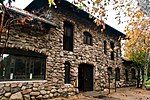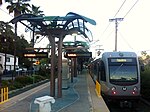Montecito View House
Houses completed in 1909Houses in Los AngelesLos Angeles Historic-Cultural MonumentsLos Angeles building and structure stubsMontecito Heights, Los Angeles

The Montecito View House, located at 4115 Berenice Place in Montecito Heights, Los Angeles, is a Craftsman bungalow designed by architect Lester S. Moore and built in 1909. It was one of the first homes constructed in Montecito Heights, and was featured on the cover of the Mutual Building Company's advertising pamphlet. Interesting aspects of the home include clinker brick and Arroyo stone chimney. The style is reminiscent of the work of Greene and Greene, Pasadena.Advocated by Charles J. Fisher, the house was declared Los Angeles Historic-Cultural Monument #529 on April 23, 1991.
Excerpt from the Wikipedia article Montecito View House (License: CC BY-SA 3.0, Authors, Images).Montecito View House
Berenice Place, Los Angeles Montecito Heights
Geographical coordinates (GPS) Address Nearby Places Show on map
Geographical coordinates (GPS)
| Latitude | Longitude |
|---|---|
| N 34.089749 ° | E -118.203164 ° |
Address
Berenice Place 4113
90031 Los Angeles, Montecito Heights
California, United States
Open on Google Maps








